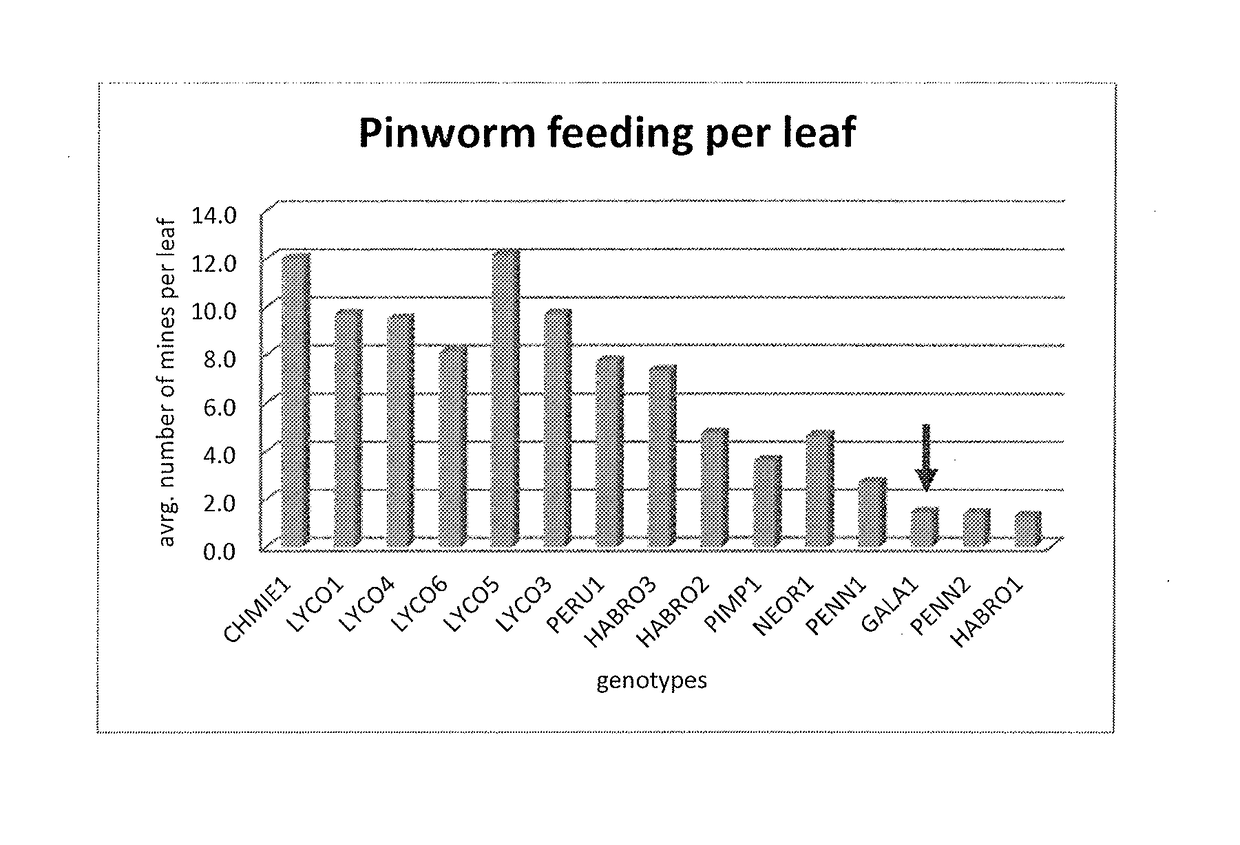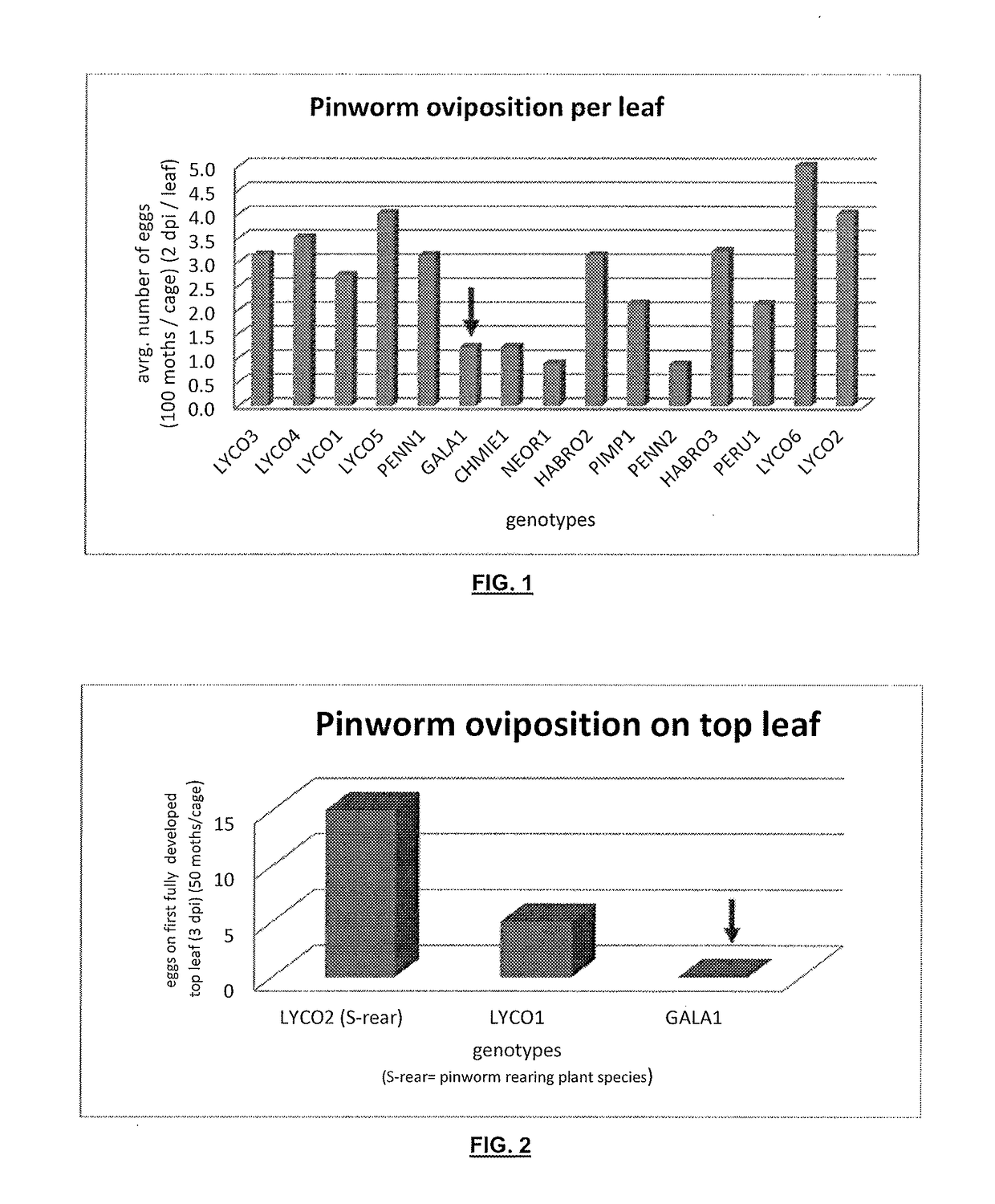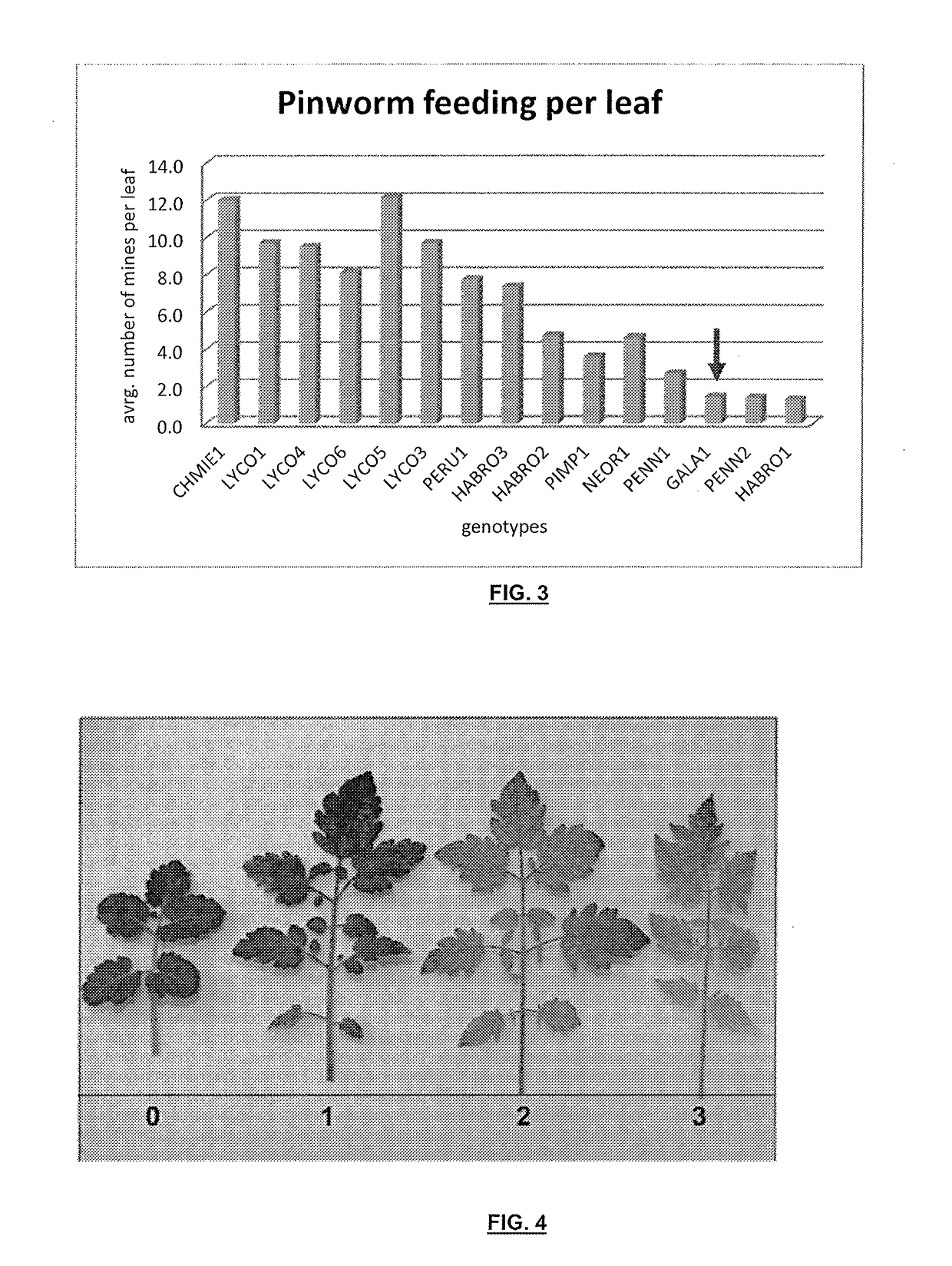Resistance to arthropod pest in tomatoes
a technology for tomatoes, applied in the field of resistance to arthropod pests in tomatoes, can solve the problems of affecting the growth of tomatoes, affecting the quality of tomatoes, and affecting the quality of tomatoes, and the current heavy application of control of arthropod pests
- Summary
- Abstract
- Description
- Claims
- Application Information
AI Technical Summary
Benefits of technology
Problems solved by technology
Method used
Image
Examples
example 2
nt of Molecular Markers and Identification of the Underlying Genetic
[0275]Materials and Methods
[0276]Plant Materials and DNA Extraction:
[0277]The discovery population for the experiment was an interspecific population derived from a cross between S. lycorpersicum (inbred cultivar LYCO1) and S. galapagense GALA1. LYCO1 was verified as susceptible to South American Pinworm, and GALA1 was identified as resistant to South American Pinworm (example 1). This population consisted of F8 Recombinant Inbred Lines (RILs) developed by Single Seed Descent.
[0278]Genomic DNA from tomato leaves was extracted using Qiagen DNeasy plant DNA extraction kit.
[0279]SNP Genotyping
[0280]A set of 737-SNPs combination was selected based on their allelic variation and evenly spaced along the genome. High-throughput SNP genotyping was carried out with the GoldenGate assays and the BeadXpress reader from Illumina. The genotypes (of the RILs and of the two parental lines) were screened with 384 markers in a singl...
example 3
Resistance of Identified RIL's of GALA1 Against Additional Organisms
[0315]Spider Mites (Tetranychus urticae)
[0316]Materials and Methods
[0317]Experimental Design
[0318]In an experimental choice setting, 19 genotypes were tested for their suitability to rear spider mites on. Test plants were grown, as described in section Tomato germplasm rearing (Example 1), until plants reached the stage of having 4 true leaves. A genotype's suitability for spider mite rearing was measured by scoring feeding symptoms in combination with observed mites and webbings constructed by the mite species under testing. The experiment contained two experimental repetitions over time, per experimental repetition there were 3 repeats with each 11 seedlings per genotype (26° C.; 16 hr light: 8 hr dark).
[0319]Infestation Method:
[0320]Test plants were infested three weeks after sowing by placing heavily infested leaves from the spidermite rearing face down on the test plants. The leaves used for infestation were pl...
example 4
Sequences of the SNPs of the Invention
[0363]The flanking sequences of the 12 SNPs of the invention and of the 12 alternative SNPs of the invention are hereby given in table 10, as well as the sequences of the additional SNPs SLC2.31_1_72272308 (position 72271870 on the tomato genome version SL2.40) and SLC2.31_9_7668450 (position 7667332 on the tomato genome version SL2.40).
TABLE 10SNP5′ flanking sequence3′ flanking sequencesolcap_snp_sl_CAAAATTTGGGAGAGCTGAAGCAAGCTAGTCAAAAGTATGCCAGTTGT18619GAGTTTCCCACTCAAGGTAAATGTGTCCTGTTGCTTGTGTATATAGTTC(SEQ ID N. 49)ATA (SEQ ID N. 1)(SEQ ID N. 2)solcap_snp_sl_AGTCTCTAACAATCAAGTTGGTGGACATTCATCTGATTCCGATCAAGAAG12348GGATATAGGCTCAGACATTGAGCTTGATGATTACGATGACCTTCCAC(SEQ ID N. 50)TGG (SEQ ID N. 3)(SEQ ID N. 4)EP_1592_LC7762GAGAAAAAGACCATTAGACAAAGAATAGAGAAAAAAAGCAAAACAGGGA(SEQ ID N. 51)AAAGGTGTTTTGATAGCTACGGAGGATGAAAGGGGTCTCTAATGGGAGAAAAAAGAGAAAG (SEQ ID N. 5)TCCATTCCCT (SEQ ID N. 6)EE_0301TAAACTAAAGTCTCCTTTTATTTTTAGGCAATTTTTATCCACACCAAATAT(SEQ ID N. 52)C...
PUM
| Property | Measurement | Unit |
|---|---|---|
| time | aaaaa | aaaaa |
| height | aaaaa | aaaaa |
| RH | aaaaa | aaaaa |
Abstract
Description
Claims
Application Information
 Login to View More
Login to View More - R&D
- Intellectual Property
- Life Sciences
- Materials
- Tech Scout
- Unparalleled Data Quality
- Higher Quality Content
- 60% Fewer Hallucinations
Browse by: Latest US Patents, China's latest patents, Technical Efficacy Thesaurus, Application Domain, Technology Topic, Popular Technical Reports.
© 2025 PatSnap. All rights reserved.Legal|Privacy policy|Modern Slavery Act Transparency Statement|Sitemap|About US| Contact US: help@patsnap.com



